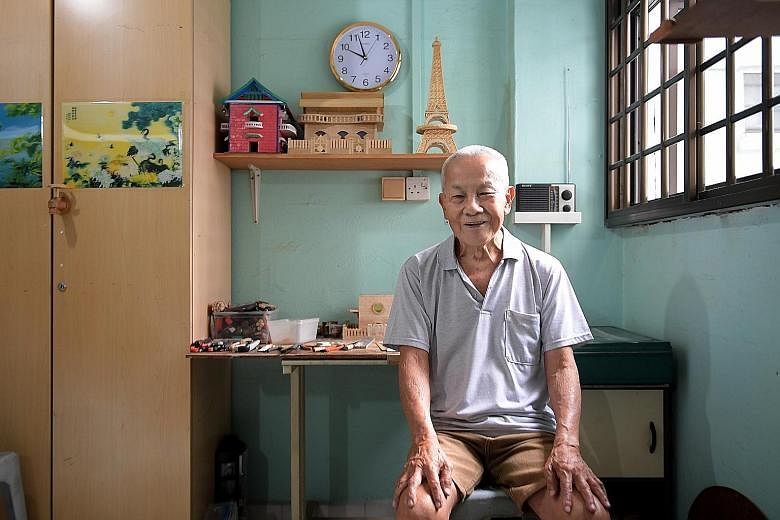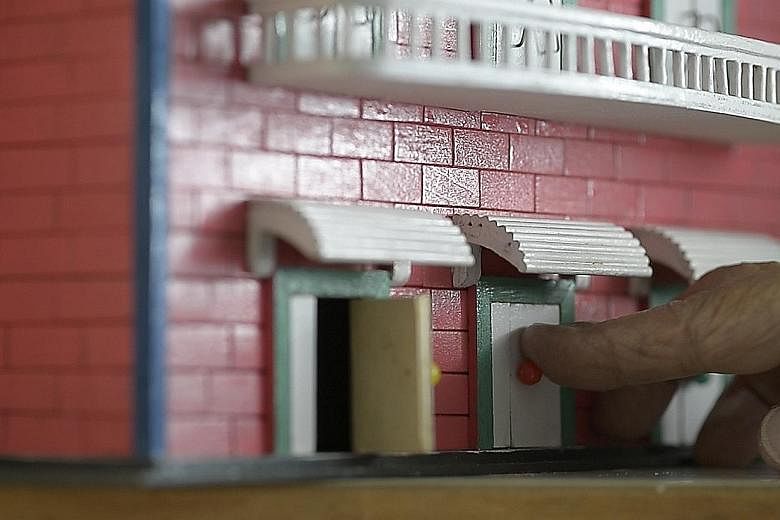Mr Sum Kin Nar retired as a carpenter about 17 years ago. But the 78-year-old is still building houses.
He used to build sprawling bungalows with gardens and swimming pools. Now he builds miniature houses about the size of a shoebox from the one-room Housing Board rental flat, where he lives alone.
The bachelor receives $500 each month in public assistance. He does not have much savings left after spending on food and utilities.
"The only furniture I have is a bed, cupboard, two tables and some stools, a TV and three old radios," he says in Mandarin when The Straits Times visited him last week in his home, which is about the size of two parking spaces.
"And this workbench."
"I am building a house now," he adds, pointing to a half-finished house made from thin strips of plywood on the workbench.
"There will be three storeys, but I have finished only one storey.
"I used to help build bungalows and terraced houses, but now I am old and I cannot work anymore.
"So I build miniature houses," he says with a laugh.
Until his retirement at age 61, Mr Sum worked as a carpenter, doing odd jobs for construction companies and renovation contractors.
He started as a carpenter's apprentice at 16, after he finished primary school. "I was not very good in my studies," he says.
His parents were street hawkers and he does not have any siblings. The family lived in an attap house in Geylang. "We were very poor," he recalls. He decided to be a carpenter to help support his family.
For two years, he earned $15 a month as an apprentice.
After he finished his apprenticeship, he started working as an independent carpenter, relying on contractors and builders to hire him for projects.
He started earning about a few dollars a day. Just before he retired, he was earning about $50 a day when there was work.
He recalls that he became very good at building staircases.
"Those with curved handrails are the hardest to build because the wood has to be shaped and carved by hand," he says.
"I could do them well because I could see the curve in my head before I carved the wood."
He recounts the heydays in the 1960s when he had jobs nearly every day, working on private houses.
One of the houses he worked on - a bungalow in the Tanglin area - belonged to a construction company boss, he says. "The taps were gold-plated," he recalls.
He was even hired by a contractor to do the carpentry work for a new hotel in Kota Kinabalu, Sabah, in the early 1970s. He spent three months in the city.
But when the HDB started ramping up its public housing programme in the 1970s, Mr Sum found his work drying up.
"People moved into flats and there were fewer private homes that needed carpenters," he says with a sigh. He tried to take a crack at the HDB construction pie, but the earnings were poor.
"An HDB contractor would pay less than $2 for a carpenter to install a wooden door, whereas a contractor for a private home would pay up to $8," he says.
Work slowed from about one job per week in the 1980s to about one or two a month in the 1990s. "I was basically a 'sangong' (casual worker in Mandarin). When I turned 60 (in 1999), nobody wanted to hire me anymore," he says.
In 2000, his mother died and he had to move out of the HDB rental flat in Joo Seng Road that was under her name. He applied for an HDB rental flat in Geylang Bahru, where he has lived alone since.
He started receiving ComCare Long Term Assistance because he did not have Central Provident Fund savings and could not find work. He also came under the care of Touch Community Services.
Staff from the voluntary welfare organisation visit him weekly to check on his well-being.
He also joins in activities such as karaoke and games organised by Touch Senior Activity Centre, which has a branch in the void deck of his block.
To pass time, he started building model houses about 10 years ago, which allows him to put his carpentry skills to good use.
"The basic principles are the same - conceptualising the house and cutting wood to build it," he says. "The only difference now is that I use super glue instead of nails and hammer."
He buys his materials from Art Friend, an art material supply shop in Bras Basah, and Daiso stores.
He takes about three to four months to build a miniature house from plywood. So far, he has built more than 10 houses.
He has sold a few for over $100 each, mainly to volunteers who visited his home and were intrigued by his work.
Besides houses, he has also built a model of the Eiffel Tower from the bamboo sticks of a sushi mat.
"I have never been to Paris, so I have to rely on photos and use my imagination," he says with a laugh.
"I don't mind selling the houses, but not this one," he says, pointing to a motorised toy of two planes spinning around a pivot.
"I made this last year and it is my first toy, so I want to keep it."
He will keep building miniature houses, both as a hobby and as a reminder of his carpentry skills.
"The big houses that I built, sometimes I would dream of living in them. Who wouldn't, right?
"But there is no chance (of me doing so) because I am poor. I can only afford this rental flat," he says, looking around him wistfully.
"(Building) the miniature houses keeps my dream alive."



